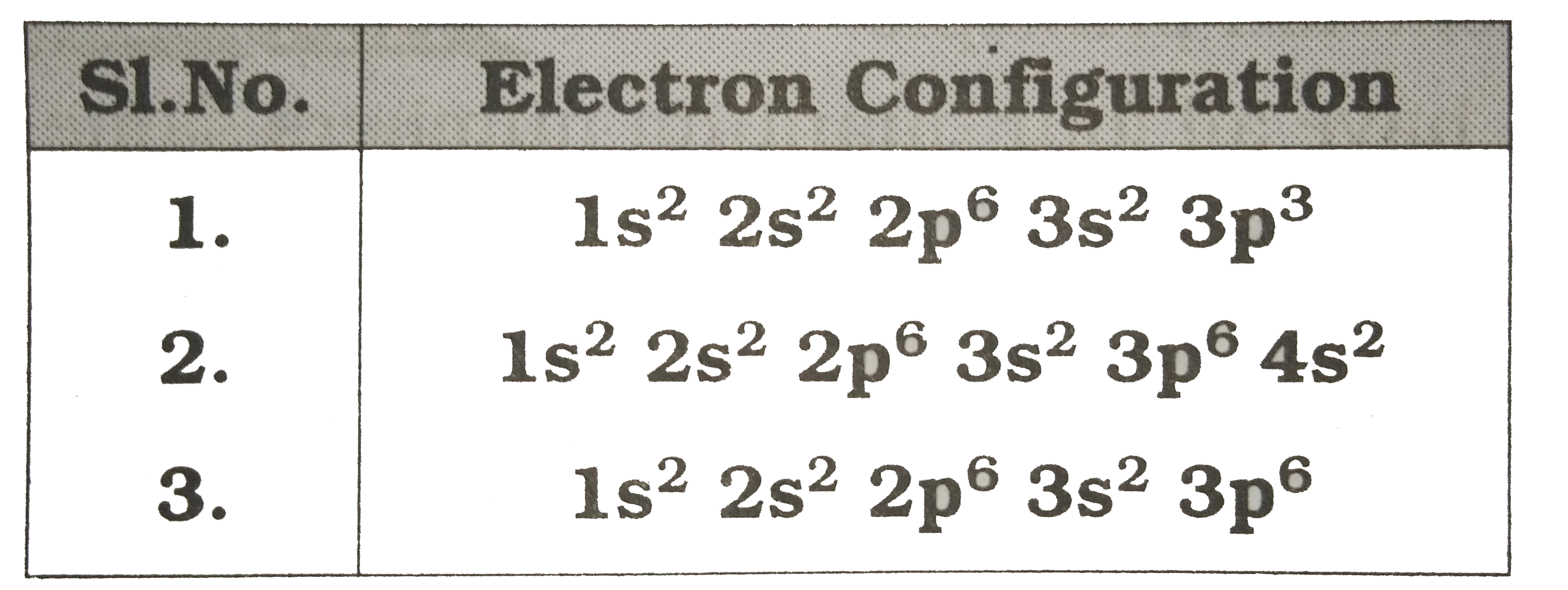Complete Solutions to CREATIVE QUESTIONS FOR NEW MODEL EXAMINATION ( SECTION - III 2 MARKS QUESTIONS ) of chapter STRUCTURE OF ATOM of Class 10 book with complete answers and questions
| Class 10 | CHEMISTRY |
| Chapter | STRUCTURE OF ATOM |
| VGS PUBLICATION-BRILLIANT | CREATIVE QUESTIONS FOR NEW MODEL EXAMINATION ( SECTION - III 2 MARKS QUESTIONS ) |
| Number Of Questions | 38 |
| Academic Year | 2023-24 |
Explain Hund's rule with an example .
View SolutionThe electronic configuration of Sodium is `1s^(2) 2s^(2) 2p^(6) 3s^(1)` .
What information that it gives ?
View SolutionName the principle , which says an orbital can hold only 2 electrons and explain .
View SolutionFor a better understanding about the electrode configuration in an atom , the teacher wrote shorthand notation `n l^(x)` on the blackboard .
Looking at this notation , what could be the probable questions that generate in the student's mind ? Write any two of them.
View SolutionWrite the electronic configuration of the atom of an element having atomic number 11 . Write the names of the rules and the laws followed by you in writing this electronic configuration .
View SolutionWrite the 'Octet Rule' . How does Mg (12) get stability while reacting with chlorine as per this rule ?
View SolutionThe electron enters into 4 s orbital after filling 3 p orbital but not into 3d . Explain the reason .
View SolutionWrite the electronic configuration of `Na^(+)` and `Cl^(-)`
View SolutionObserve the given table and answer the question

Mention the divalent element name .
View SolutionObserve the given table and answer the question

Name the element belongs to `3^(rd)` period and VA Group
View SolutionYour friend is unable to understand `n l^(x)` . What questions will you ask him to understand ` n l^(x)` method ?
View SolutionWhy do valency electrons involve in bond formation , than electrons of inner shells ?
View SolutionWhat are characteristics of electromagnetic waves ?
View SolutionWrite Planck's equation .
View SolutionGive the equation which give electromagnetic energy (light) that can have only certain discrete energy values .
View SolutionExplain Pauli's Exclusion principle with an example.
View SolutionExplain Aufbau principle with an example .
View SolutionThere is an electron in one atom with n = 1, l = O, `m_(l) = O`.
a) Predict the name of the orbit in which it lies ?
b) Predict the name of the orbital in which it lies?
View SolutionGuess the orbital.
If 1) It's energy lies in between the energies of 4s and 4d.
2) It can hold only 2 electrons.
View SolutionThe electronic configuration of an atom is as follows `1s^(2) 2s^(2) 2p^(2)`
a) Which element's atom is it ?
b) What is the valence shell ?
c) When excited what could be the number of lone / single electrons in this atom ?
d) What is the value of principal quantum numbers of two electrons in the first box ?
View SolutionFill the following table and write the rule which you use in filling the table .

View SolutionAn electron is an atom has the following set four quantum numbers to which orbits it belongs to ?

View SolutionYou know that the distribution of electrons in shells, sub-shells and orbitals in an atom is known as electronic configuration.
Now answer the question by using the electronic configuration `1s^(2) 2s^(2) 2p^(1)`
How many shells are there? What are they?
View SolutionYou know that the distribution of electrons in shells, sub-shells and orbitals in an atom is known as electronic configuration.
Now answer the question by using the electronic configuration `1s^(2) 2s^(2) 2p^(1)`
How many sub-shells are there ? What are they ?
View SolutionThe differentiating electron in one atom is `4p^(1)` .
Write the set of 3 quantum numbers for it.
View SolutionThe differentiating electron in one atom is `4p^(1)` .
Write the full electronic configuration of the atom.
View SolutionFor n = 3.
Write all the `m_(l)` values.
View SolutionFor n = 3.
Write all the sub-shells
View Solution
Write the name of the atom and electronic configuration for the given block diagram.
View Solution
Where does the `6^(th)` electron go?
View SolutionAmong 3d, 4s, 4p orbitals,
which one has least orbital energy ? Why ?
View SolutionAmong 3d, 4s, 4p orbitals,
which one fills last by an electron? And why?
View SolutionShow all the p-orbitals in one diagram.
View SolutionDraw `d_(x^(2) - y^(2))` orbital and `P_(z)` orbital.
View SolutionDraw the diagram of electromagnetic wave
View SolutionHow do you appreciate the Planck?
View SolutionWhat are the minimum and maximum frequency of a visible light ?
View SolutionComplete the following table based on quantum numbers related to atomic orbitals and electron of an atom .

View Solution
CREATIVE QUESTIONS FOR NEW MODEL EXAMINATION ( SECTION - III 2 MARKS QUESTIONS ) questions and complete solutions for chapter STRUCTURE OF ATOM of VGS BRILLIANT CHEMISTRY (TELUGU ENGLISH) of Class 10
All Exercises from VGS PUBLICATION-BRILLIANT Class 10 CHEMISTRY STRUCTURE OF ATOM
- ACTIVITIES
- CREATIVE QUESTIONS FOR NEW MODEL EXAMINATION ( SECTION - I 1/2 MARK QUESTIONS)
- CREATIVE QUESTIONS FOR NEW MODEL EXAMINATION ( SECTION - II 1 MARK)
- CREATIVE QUESTIONS FOR NEW MODEL EXAMINATION ( SECTION - III 2 MARKS QUESTIONS )
- CREATIVE QUESTIONS FOR NEW MODEL EXAMINATION ( SECTION - IV 4 MARKS )
- QUESTIONS GIVEN IN THE LESSONS ( 1 MARKS QUESTIONS)
- QUESTIONS GIVEN IN THE LESSONS ( 2 MARKS QUESTIONS)
- QUESTIONS GIVEN IN THE LESSONS ( 4 MARKS QUESTIONS)
- TEXTUAL LESSON PART ( ASKING QUESTIONS AND MAKING HYPOTHESIS)
- TEXTUAL LESSON PART ( CONCEPTUAL UNDERSTANDING )
- TEXTUAL LESSON PART ( FILL IN THE BLANKS)
- TEXTUAL LESSON PART ( INFORMATION SKILLS AND PROJECTS)
- TEXTUAL LESSON PART ( MULTIPLE CHOICE QUESTIONS)
- TEXTUAL LESSON PART (APPLICATION TO DAILY LIFE , CONCERN TO BIODIVERSITY)